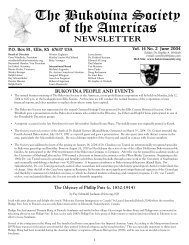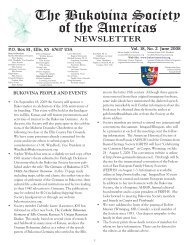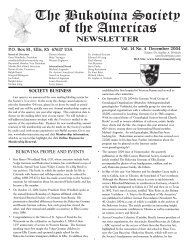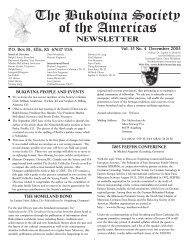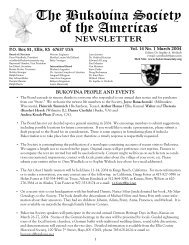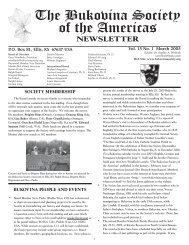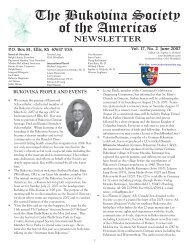newsletter - Bukovina Society of the Americas
newsletter - Bukovina Society of the Americas
newsletter - Bukovina Society of the Americas
Create successful ePaper yourself
Turn your PDF publications into a flip-book with our unique Google optimized e-Paper software.
he represented South Paraná including Rio Negro, and City<br />
Councilor, Dr. Swarowski always found time to participate at<br />
<strong>the</strong> festivities <strong>of</strong> his <strong>Bukovina</strong> compatriots. In his book, Os<br />
Bucovinos do Brasil . . . e a História de Rio Negro (p. 549),<br />
Pr<strong>of</strong>essor Ayrton Celestino acknowledges his many contributions<br />
to <strong>the</strong> success <strong>of</strong> <strong>the</strong>ir endeavors. Nor has <strong>the</strong> family’s<br />
support <strong>of</strong> Bukovinian activities ceased with Alceu Antônio’s<br />
demise. In 1994 his son, Alceu Ricardo Swarowski, as mayor,<br />
signed a law naming <strong>the</strong> street leading into Rio Negro in <strong>the</strong><br />
Bairro Bom Jesus as Praça Bucovina (<strong>Bukovina</strong> Square). This<br />
place has special significance since it was here that our<br />
Bukovinian immigrant compatriots first set foot in 1887.<br />
• The Bucovina Institute <strong>of</strong> <strong>the</strong> Romanian Academy, Radautz,<br />
Romania, founded in 1992 to study and research <strong>the</strong> history<br />
and culture <strong>of</strong> <strong>Bukovina</strong>, has sent us a courtesy copy <strong>of</strong> <strong>the</strong><br />
first two issues <strong>of</strong> <strong>the</strong>ir publication, Analele Bucovinei<br />
(<strong>Bukovina</strong> Annals). President Marcy McClelland in turn sent<br />
several <strong>of</strong> our books and publications to <strong>the</strong>ir research center.<br />
• The <strong>Society</strong> has been receiving <strong>the</strong> <strong>newsletter</strong> <strong>of</strong> <strong>the</strong> Indiana<br />
German Heritage <strong>Society</strong>, which, with <strong>the</strong> IUPUI Max Kade<br />
German-American Center, issues <strong>the</strong> <strong>newsletter</strong>. The<br />
former IGHS Newsletter is now available online with a oneyear<br />
embargo to favor paid members. To view back issues, see<br />
<strong>the</strong> website at www.ighs.org and click on Newsletter Archive.<br />
• Dr. Valentin Reitmajer (Munich, Germany), who published a<br />
cookbook featuring <strong>the</strong> traditional German Bohemian<br />
cuisine, has donated his stipend from sales <strong>of</strong> his book to <strong>the</strong><br />
<strong>Society</strong>. German-Bohemian Cookery in 19th Century <strong>Bukovina</strong><br />
is one <strong>of</strong> <strong>the</strong> best sellers on <strong>the</strong> <strong>Society</strong>’s website Store:<br />
www.bukovinasociety.org/store.html<br />
BOOK REVIEW<br />
Kurt Scharr. Die Bukowina: Entdeckung einer Kulturlandschaft:<br />
Ein Reiseführer [<strong>Bukovina</strong>: Discovery <strong>of</strong> a Cultural Landscape: A<br />
Travel Guide]. Vienna/ Cologne/Weimar: Böhlau Verlag, 2007.<br />
Pp. 155.<br />
Reviewed by Michael Augustin (Leonberg, Germany)<br />
In <strong>the</strong> spring <strong>of</strong> 2007 Kurt Scharr published <strong>the</strong> first Germanlanguage<br />
book about <strong>Bukovina</strong> to appear in quite a while. The<br />
subtitle: Entdeckungen einer Kulturlandschaft: Ein Reiseführer is a<br />
bit misleading in that only about half <strong>the</strong> paperback can be<br />
described as a travel guide. The author, who studied geography<br />
and history in Innsbruck, devotes <strong>the</strong> first section to <strong>Bukovina</strong> in<br />
general. Here he concentrates on its geography, ethnic groups,<br />
cultural and political classifications as well as its history including<br />
its economic and social development. The historic section <strong>of</strong>fers a<br />
concise presentation with interesting and occasional new aspects<br />
and relationships, which even <strong>the</strong> reader who is knowledgeable on<br />
<strong>the</strong> topic will find <strong>of</strong> value. Contemporary happenings are not<br />
thoroughly explored and considered only in isolated instances; as a<br />
result, <strong>the</strong> reader will not glean a deeper understanding <strong>of</strong> <strong>the</strong><br />
current scene, which was perhaps so intended.<br />
The second section, <strong>the</strong> actual travel guide, encompasses four<br />
possible routes for exploring <strong>the</strong> countryside plus two strolls<br />
through Czernowitz, <strong>the</strong> former capital <strong>of</strong> <strong>Bukovina</strong>. In <strong>the</strong> latter<br />
<strong>the</strong> author discusses <strong>the</strong> Austrian and Romanian eras through<br />
1945 followed by <strong>the</strong> post-World War II Soviet-Ukrainian period.<br />
2<br />
All three one-day trips begin and end in Czernowitz: (1) to<br />
Waschkiwizi, Wischnizja, Beregomet and Storoschynez; (2) to<br />
Chotin, Kamjanez-Podilskij, Skala-Podilska, Kasperiwizi and<br />
Salischtschiki; and (3) to Bila Krinizja, Siret, Dragomirna and<br />
Suceava. The fourth, a two-day journey, starts in Suceava and<br />
continues to Mestecanis, Ciocanesti, Cirlibaba, Jacobeni and<br />
Vatra Dornei on day one with return <strong>the</strong> next day via Moldovita,<br />
Ciumarna, Sucevita, Marginea, Putna, Solca, and Cacica back to<br />
Suceava. Only fleeting mention is made <strong>of</strong> several <strong>of</strong> <strong>the</strong> worldrenowned<br />
Moldavian monasteries. The partial elaboration <strong>of</strong> <strong>the</strong><br />
routes with pictures <strong>of</strong> <strong>the</strong> places to be visited is very informative.<br />
The reader might well benefit from a few regional maps for<br />
purposes <strong>of</strong> geographic orientation. Street maps <strong>the</strong> size <strong>of</strong><br />
matchbook covers, which accompany background information on<br />
towns and villages mentioned in <strong>the</strong> text, have decorative value at<br />
best.<br />
In conclusion, this book is a contribution to an enhanced understanding<br />
<strong>of</strong> <strong>Bukovina</strong>. The reader may well envision himself in its<br />
scenic and cultural milieu and be tempted to set foot on <strong>the</strong> routes<br />
described by <strong>the</strong> author.<br />
Die <strong>Bukovina</strong> can be obtained for 19.90 euros from Böhler Verlag,<br />
Wiesingerstrasse 1, 1010 Vienna, Austria or www.boehlau.at><br />
1907 KANSAS GERMAN-BOHEMIAN WED-<br />
DING CELEBRATION RECOUNTED<br />
by Steve Parke (Pueblo West, CO)<br />
On a weekly basis <strong>the</strong> Western Kansas World <strong>of</strong> WaKeeney,<br />
Kansas, publishes a column compiled by Cathy Millard, <strong>the</strong> “100<br />
Year Files <strong>of</strong> <strong>the</strong> Western Kansas World.” The column recounts<br />
selected 100-year-old news items describing <strong>the</strong> history and local<br />
culture <strong>of</strong> <strong>the</strong> area in an informative and <strong>of</strong>ten entertaining<br />
manner. WaKeeney is twenty miles west <strong>of</strong> Ellis, Kansas.<br />
In <strong>the</strong> November 22, 2007 edition <strong>of</strong> <strong>the</strong> World <strong>the</strong> “100 Year<br />
Files” noted a great piece <strong>of</strong> local <strong>Bukovina</strong> cultural history with a<br />
quote from a November 1907 Big Creek neighborhood news<br />
column. The Big Creek column appears to refer to happenings<br />
generally in <strong>the</strong> Big Creek neighborhood just west <strong>of</strong> Ellis.<br />
Several news postings in this column also mention Ellis.<br />
The quote <strong>of</strong> interest reads: “Ye scribe learns that a good time was<br />
had by all at <strong>the</strong> Nemecek wedding last Tuesday. There were<br />
sixteen kegs <strong>of</strong> beer, also fifteen dressed geese, one beef, and four<br />
fatted hogs butchered for <strong>the</strong> feeding <strong>of</strong> <strong>the</strong> guests, and that<br />
dancing and card playing were <strong>the</strong> order <strong>of</strong> <strong>the</strong> day Tuesday and<br />
<strong>the</strong> guests continued <strong>the</strong> festivities until Wednesday evening.”<br />
If those numbers might sound fanciful to some, <strong>the</strong> author made<br />
sure that we got it right as <strong>the</strong> numbers were spelled out. This<br />
must have been quite <strong>the</strong> wedding or should I say party? The<br />
article reveals a number <strong>of</strong> historical and cultural <strong>the</strong>mes <strong>of</strong> <strong>the</strong><br />
German Bohemians <strong>of</strong> <strong>Bukovina</strong>.<br />
The local German Bohemian Nemecek family arrived from<br />
<strong>Bukovina</strong> in 1898 and lived just south <strong>of</strong> Ellis in Ellis County.<br />
This family had lived in Furstenthal, <strong>Bukovina</strong> since at least 1805<br />
when Mathias Nemeczek married Barbara Stark. Many <strong>of</strong> <strong>the</strong>



